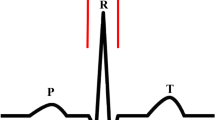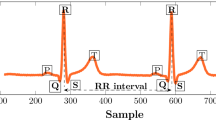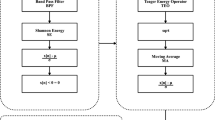Abstract
The accurate delineation of R peaks in an ElectroCardioGram (ECG) is required for analysis and diagnosis of various cardiac abnormalities. Detection of the R peak is a challenging task due to the presence of various artifacts and varying morphology of the ECG signal in inter- and intrasubject. In this paper, an effective and novel algorithm for the accurate detection of R peaks in the single-lead ECG signal is proposed. The QRS complex is enhanced by removing P, T waves and other artifacts using combination of wavelet transform, derivatives and Hilbert transform. The enhanced QRS complex is detected by adaptive thresholding. This method is robust against inter- and intrasubject variations of the ECG signal morphology and also provides high degree of accuracy for very noisy signals. The algorithm is tested on all the signals of MIT-BIH arrhythmia Database, QT database and noise stress database taken from physionet.org (Massachusetts Institute of Technology, Biomedical Engineering Center, Cambridge, MA, 1992. www.physionet.org/physiobank/databse/html/mitdbdir/mitdbdir.htm). The performance of the algorithm is confirmed by sensitivity of 99.9%, positive predictivity of 99.9% and detection accuracy of 99.8% for R peaks detection.








Similar content being viewed by others
References
M.L. Ahlstrom, W.J. Tompkins, Automated high-speed analysis of Holter tapes with microcomputers. IEEE Trans. Biomed. Eng. 30, 651–657 (1983)
S. Banerjee, M. Mitra, ECG feature extraction and classification of anteroseptal myocardial infarction and normal subjects using discrete wavelet transform, in Proceedings of IEEE International Conference on Systems in Medicine and Biology, IIT Kharagpur (2010), pp. 55–59
D. Benitez, P.A. Gaydecki, A. Zaidi, A.P. Fitzpatrick, The use of Hilbert transform in ECG signal analysis. Comput. Biol. Med. 31, 399–406 (2001)
F. Chiarugi, V. Sakkalis, D. Emmanouilidou, T. Krontiris, M. Varaniniand, I. Tollis, Adaptive threshold QRS detector with best channel selection based on a noise rating system. Comput. Cardiol. 34, 157–164 (2007). doi:10.1109/CIC.2007.4745445
D.A. Coast, R.M. Stern, G.G. Cano, S.A. Briller, An approach to cardiac arrhythmia analysis using hidden Markov models. IEEE Trans. Biomed. Eng. 37(9), 826–836 (1990)
M. Elgendi, M. Jonkman, F. De Boer, R wave detection using Coiflets wavelets, in IEEE 35th Annual Northeast Bioengineering Conference, Boston (2009), pp. 1–2
M. Elgendi, B. Eskofier, S. Dokos, D. Abbot, Revisiting QRS detection methodologies for portable wearable, battery-operated and wireless ECG systems. PLoS ONE 9(1), 1–18 (2014)
P.S. Hamilton, W.J. Tompkins, A real time QRS detection algorithm. IEEE Trans. Biomed. Eng. 32(3), 230–236 (1985)
X. Hongyan, H. Minsong, A new QRS detection algorithm based on empirical mode decomposition, in Proceedings of the 2nd International Conference on Bioinformatics and Biomedical Engineering (2008), pp. 693–696
Y.H. Hu, W.J. Tompkins, J.L. Urrusti, V.X. Afonso, Applications of artificial neural networks for ECG signal detection and classification. J. Electrocardiol. 26, 66–73 (1993)
D. Kaplan, Simultaneous QRS detection and feature extraction using simple matched filter basis functions, in Proceedings of Computers in Cardiology, 3rd edn. (1990), pp. 503–506. doi:10.1109/CIC.1990.144266
B.U. Kohler, C. Hennig, R. Orglmeister, QRS detection using zero crossing counts. Prog. Biomed. Res. 8(3), 138–145 (2003)
C. Li, C. Zheng, C. Tai, Detection of ECG characteristic points using wavelet transforms. IEEE Trans. Biomed. Eng. 42(1), 21–28 (1995)
Y. Ma, T. Li, Y. Ma, K. Zhan, Novel real time FPGA based R wave detection using lifting wavelet. Circuit Syst. Signal Process. 35(1), 281–299 (2016). doi:10.1007/s00034-015-0063-z
MIT-BIH Arrythmia Database (Massachusetts Institute of Technology, Biomedical Engineering Center, Cambridge, MA, 1992), www.physionet.org/physiobank/databse/html/mitdbdir/mitdbdir.htm
M. Okada, A digital filter for the QRS complex detection. IEEE Trans. Biomed. Eng. 26(12), 700–703 (1979). doi:10.1109/tbme.1979.326461
J.J.J.H. Park, V.C.M. Leung, C.-L. Wang, T. Shon, Future Information Technology, Application and Service, Future Tech 2012 Proceedings (2012), p. 1
R. Polikar, The Wavelet Tutorial, users.rowan.edu/ polikar/ Wavelets/WTpart1.html
H. Rabbani, M.P. Mahjoob, E. Farahabadi, A. Farahabadi, R peak detection in electrocardiogram signal based on an optimal combination of wavelet transform, Hilbert transform and adaptive thresholding. J. Med. Signals Sens. 1(2), 91–98 (2011)
M. Sabarimalai Manikandan, K.P. Soman, A novel method for detecting R-peaks in electrocardiogram (ECG) signal. Biomed. Signal Process. Control 7(2), 118–128 (2012)
J.S. Sahambi, S. Tandon, R.K.P. Bhatt, Using wavelet transform for ECG characterization. IEEE Eng. Med. Biol. Mag. 16(1), 77–83 (1997)
P.E. Trahanias, An approach to QRS complex detection using mathematical morphology. IEEE Trans. Biomed. Eng. 40(2), 201–205 (1993)
Z. Zidelmal, A. Amirou, D. Ould-Abdeslam, A. Moukadem, A. Dieterlen, QRS detection using S-transform and Shannon energy. Comput. Methods Progr. Biomed. 116(1), 1–9 (2014). doi:10.1016/j.cmpb.2014.04.008
Author information
Authors and Affiliations
Corresponding author
Rights and permissions
About this article
Cite this article
Sabherwal, P., Agrawal, M. & Singh, L. Automatic Detection of the R Peaks in Single-Lead ECG Signal. Circuits Syst Signal Process 36, 4637–4652 (2017). https://doi.org/10.1007/s00034-017-0537-2
Received:
Revised:
Accepted:
Published:
Issue Date:
DOI: https://doi.org/10.1007/s00034-017-0537-2




